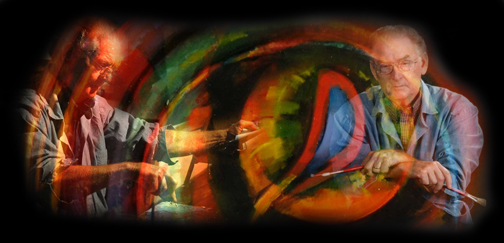- Updated Bio Coming Soon -
E.W. RINGSTAFF: PERSPECTIVE OF AN ARTIST
By Susan Etchey (Freelance writer) Moore Haven, FL September, 2007
A brilliant metaphysical artist, E. W. Ringstaff, has evolved his signature style over 40 years, working without fanfare. Consistent work, inspiration and an extraordinary imagination has made him a master of a biomorphic Surrealism; his symbolic forms subtle yet shocking to the eye force you to ponder. His heavy dream images convey his own emotional quandaries. Human doubts and fears, the foibles of faith emit from his canvases as universal expressions.
Ringstaff’s “Symbols That Carry the Human Spirit” are dynamic and disturbing dramas that fill his canvas. His intense work is often couched in the dichotomy of good versus evil; faith versus logic; organized religion versus tribal beliefs. Free of restraints, he paints what he thinks, not what he sees. His symbolism unveils a critical mind expressing his own lifetime of a spiritual quest.
Ringstaff has not sought fame or fortune over his life span as an artist. He has always been a loner in the world of art. Doing the work -not talking about doing the work- is what has impassioned his life. After many years earning an income as an art teacher, as a prolific and popular portrait artist, the versatile artist was able to finally break loose from societal bonds and he paints what inspires him, what he imagines.
In the 1970s the disciplined artist designed and built an amazing sky lighted studio where few people are invited. The odd-sized rectangular building sits anonymously in the midst of cane field country on a quiet road. There he goes nearly every day of his life to paint in solitude.
Painting keeps him sane, says Ringstaff. He paints a minimum of three hours a day but it happens often eight hours will pass in his private studio before he tears himself away.
While his personal life seems quite ordinary and family-oriented, Ringstaff’s art is anything but ordinary. In his small town life in the conservative South, his art is hardly known or understood by his neighbors and local farmers. The pragmatic agricultural environment may be stifling to a more cosmopolitan spirit, but it hasn’t deterred Ringstaff’s focus on his work. With a steady stream of work created over the years, much of it stacked in rows and rafters in the studio, Ringstaff has progressed from being a good working artist at a young age to becoming a great artist in his maturity.
Ringstaff’s eclectic studio belies a very different person than the public face he wears. His artistic genius is that he creates outside the frame of convention and conformity; not a comfortable zone for even his own circle of friends and family. But at 67, Ringstaff has begun to feel the gnawing of time. “What I hope is that people will see what I have done with my work and take an interest in it. I want my work to have value and not end up in the trash,” he says with some sorrow. Like many truly gifted artists, marketing his work is a distraction, a chore he dislikes. He fears his anonymity may have hurt his chances of having his life’s work respected and revered.
In the realm of aesthetics, Ringstaff is a self-actualizing original artist. The work of Edvard Munch and Paul Klee has inspired him. Ringstaff studied under renowned artists including Robert Moore, Jack Winthrop and Trudy Gordon, but it is not their influence identifiable in his work. The ideas of Joseph Campbell, who taught mythology at Sarah Lawrence and the novelist James Joyce have to a great measure influenced Ringstaff’s works of art, and he likens them to his intellectual and spiritual gurus.
This series of paintings “Symbols That Carry the Human Spirit”, like all creative ideas, shows its value in that, like keys, they help unlock obscure connections of facts, and thus enable us to penetrate deeper into the mysteries of life. |
